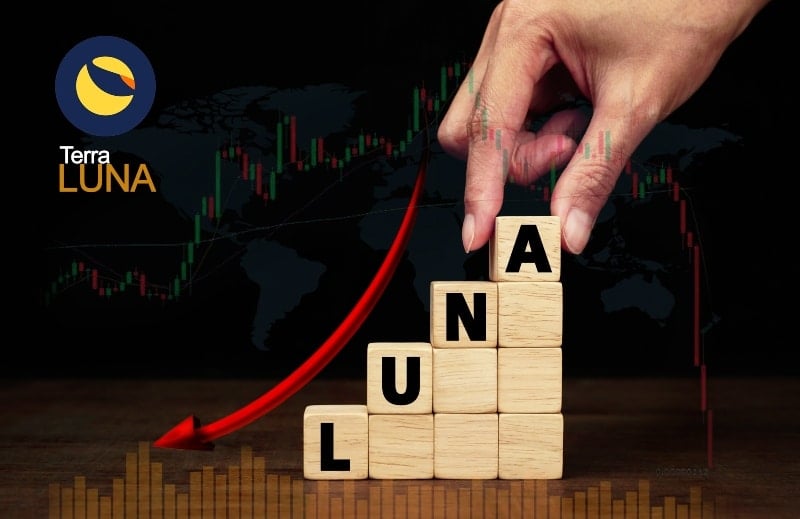In the following article, we will look at what is really behind one of the biggest failures in cryptocurrency history: the Terra ecosystem.
When the entire ecosystem behind the Terra project and its UST stablecoin collapsed about a fortnight ago, the world of cryptocurrencies experienced a real earthquake. For a moment, it was feared that this collapse would cause a real upheaval in the crypto world and especially in the stablecoin world.
Summary
How the Terra project was born

Founded in 2018 ago by Koreans Daniel Shin and Do Kwon, Terra is a protocol on which more and more payment platforms were being developed, geographically located in particular in the Asia-Pacific region.
It is a blockchain created to facilitate global and decentralized payments. To do this, the company that created the project, the Korean Terraform Labs, issued two stablecoins, UST and KRT, pegged to the US Dollar and Korean Won, respectively, thanks to an algorithm based on the LUNA supply.
The blockchain immediately became a catalyst for many projects related mainly to decentralized finance, and in just under a year, the listing of its native token, LUNA, jumped from $1 to $42, entering the top fifteen most capitalized cryptocurrencies.
The token, in the minds of its creators, was meant to stabilize the prices of the project’s two stablecoins. LUNA holders could also participate and vote on governance proposals in the network, via the Proof-of-Stake system.
How the collapse began
Then, on 9 May, the main stablecoin, UST, lost its peg to the dollar, causing the entire ecosystem to collapse in a matter of hours and resulting in a loss of around $60 billion.
The price of LUNA quickly dropped to practically zero, while the stablecoin was valued at around $0.13 at the end of the day.
It is difficult to understand the precise reasons for such a sudden collapse, even though some warnings of what later happened had already been given in April. The collapse was undoubtedly caused by the UST stablecoin that lost its peg to the dollar, causing the whole project to fail.
The stablecoins represent a kind of compensation for the cryptocurrency market precisely because they are supposed to be backed by fiat currency reserves. This assumption clearly did not exist for UST, which is an algorithmic stablecoin. It relies on a particular code to maintain its peg to the dollar.
In the six months leading up to the collapse, UST was being bought up by investors because of its very high yields, up to 20%, which later proved to be absolutely unsustainable, because it made the currency look like a highly speculative instrument and thus went against the very theory behind stablecoins.
According to some, this closely resembled a classic Ponzi scheme, considering that the project could not possibly guarantee such returns.
Based on the data from April, some large investors allegedly borrowed Bitcoin to buy UST, and when these large investors then decided to get back out of their positions by taking cover, the price of the stablecoin started to fall. This caused a snowball effect of massive selling, which led to the collapse of the stablecoin and the LUNA token.
Analysis and thoughts of experts before the crash
Joey Krug, co-chief investment officer of the Pantera Capital fund, said in an interview with CNBC that they sold about 87% of their position in LUNA and UST from January 2021 to April 2022. Pantera then sold another 8% in May once it became clear that the system might collapse.
Stuti Pandey, risk partner at Farmer Fund, said:
“What the Luna ecosystem did was they had a very aggressive and optimistic monetary policy that pretty much worked when markets were going very well, but they had a very weak monetary policy for when we encounter bear markets”.
The collapse of UST has heightened the concerns of the financial world, which has long raised doubts about the resilience of the entire stablecoin system, starting with the largest, Tether, whose soundness in terms of reserves has been repeatedly questioned.
Sam MacPherson, an engineer at MakerDAO and co-founder of software design company Bellwood Studios, argues that:
“The way these algorithmic stablecoins are designed, they have this upward force during bull markets, which is how they get so popular. But the same forces act in reverse during bear markets and expose their fundamental flaws. So that is eventually what triggered [the crash]”.
In the past few days, to worsen the situation, came the news of a possible laundering of $4.8 million by Terraform Labs through a Korean subsidiary, which some claim is a shell company.
Terra attempts to rise from the ashes despite all doubts and misgivings
Terra’s many supporters are currently trying to revive a new project called Terra 2.0, with a new token, also listed on Binance. The new crypto, which debuted on 28 May at $29, dropped to $7 within minutes, then stabilized at around $6, a tangible sign that the trust placed in the Terra name is now being seriously questioned.
Now what many experts are predicting will probably be a new clampdown on cryptocurrency regulation to prevent a repeat of similar episodes.
Furthermore, Senator Elizabeth Warren had reiterated to the Senate Treasury Committee the need for precise regulation of the stablecoin markets, which she described as the “lifeblood” for the dangerous DeFi market.




